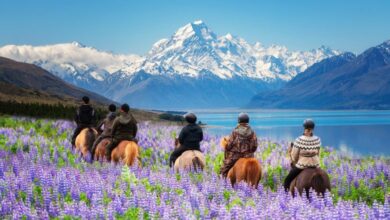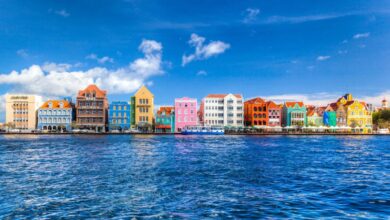

The global travel industry is experiencing an unprecedented transformation, emerging from pandemic-era restrictions into a new golden age characterized by fundamental shifts in traveler behavior, destination preferences, and industry structures. This isn’t merely a recovery—it’s a complete reimagining of how people explore the world, driven by technological innovation, changing values, and new economic realities. From digital nomadism and sustainable tourism to experiential travel and space tourism, the travel landscape is being reshaped by powerful trends that are creating both challenges and opportunities for destinations, businesses, and travelers alike. This comprehensive analysis explores the key forces driving this global travel revolution and examines their implications for the future of tourism worldwide.
A. The Digital Nomad Revolution: Work from Anywhere Culture
The normalization of remote work has unleashed a massive wave of location-independent professionals who are transforming travel from brief vacations to extended immersive experiences.
A. Destination Visa Innovation: Countries worldwide are competing to attract remote workers through specialized visa programs and infrastructure development.
-
Digital Nomad Visa Programs: Over 50 countries now offer specialized visas for remote workers, with programs like Portugal’s D7 Visa, Barbados’ Welcome Stamp, and Estonia’s Digital Nomad Visa leading the way. These initiatives typically offer extended stays (6-24 months) with streamlined application processes and favorable tax treatments, creating new revenue streams for host countries without displacing local employment.
-
Co-Living and Co-Working Infrastructure: Purpose-built spaces like Selina, Roam, and Outsite are creating integrated environments that combine comfortable accommodation with reliable workspaces and community activities. These developments often include high-speed internet, meeting rooms, and social programming specifically designed for remote workers, generating premium revenue compared to traditional tourism.
-
Remote Work Certification Programs: Destinations are implementing certification programs like Croatia’s “Digital Nomad Ready” initiative to ensure businesses meet specific standards for remote worker support. These certifications help digital nomads identify locations with reliable infrastructure while encouraging local businesses to upgrade their offerings.
B. Extended Stay Tourism Economics: The rise of long-term travel is creating new economic models for the tourism industry.
-
Monthly Rental Premiums: Accommodation providers are adapting pricing models to capture the extended stay market, with discounts of 20-40% for monthly bookings compared to nightly rates. This approach provides more predictable revenue while reducing operational costs associated with frequent turnover.
-
Local Economic Integration: Extended stays create deeper economic connections as travelers shop locally, use neighborhood services, and develop relationships with community members. Research indicates that digital nomads typically spend 2-3 times more than traditional tourists over their extended stays while distributing spending across more local businesses.
-
Seasonal Smoothing: The digital nomad movement helps destinations address seasonality challenges by attracting visitors during traditional shoulder seasons. Locations like Mexico City, Lisbon, and Bangkok have seen their tourism seasons extend significantly as remote workers choose to avoid peak tourist months.
C. Travel Technology Ecosystem: A sophisticated digital infrastructure has emerged to support the location-independent lifestyle.
-
Nomad-Focused Platforms: Services like Nomad List, Remote Year, and WiFi Tribe provide curated information about destinations, organize group travel experiences, and facilitate community connections. These platforms reduce the friction of long-term travel while creating valuable networking opportunities.
-
Remote Work Tools Evolution: The rapid improvement of collaboration tools like Zoom, Slack, and Asana has made distributed work more feasible, while specialized services like SafetyWing provide global health insurance tailored to digital nomads’ unique needs.
-
Destination Research Resources: Comprehensive online resources covering everything from visa requirements to co-working quality to healthcare access have dramatically reduced the information barriers that previously limited long-term international travel.

B. Sustainable and Regenerative Tourism: The Green Travel Revolution
Environmental and social consciousness is transforming how travelers choose destinations, select accommodations, and interact with local communities.
A. Carbon-Neutral Travel Initiatives: The tourism industry is responding to growing climate concerns with comprehensive sustainability programs.
-
Carbon Offset Integration: Major airlines including Delta, United, and British Airways now offer integrated carbon offset programs at booking, with some carriers making offsets automatic for all flights. Meanwhile, platforms like Sustainable Travel International help travelers calculate and offset their entire trip footprint, not just flights.
-
Electric Transportation Networks: Destinations are rapidly electrifying ground transportation, with countries like Norway and the Netherlands leading in electric rental car availability and charging infrastructure. Tour operators are increasingly incorporating electric vehicles, bicycles, and walking to reduce the carbon footprint of ground activities.
-
Sustainable Aviation Fuel Development: Airlines are making significant investments in Sustainable Aviation Fuel (SAF), with carriers like United committing to SAF purchases equivalent to their total annual fuel consumption by 2050. While currently limited by production capacity, SAF represents the most promising pathway to decarbonizing air travel.
B. Regenerative Tourism Models: Beyond minimizing harm, the industry is increasingly focused on creating positive impacts.
-
Community-Based Tourism Development: Initiatives like G Adventures’ Planet Promise and Intrepid Travel’s community tourism projects ensure local communities retain ownership and receive direct economic benefits from tourism. These models typically direct 60-80% of spending to local businesses compared to 20-40% in conventional tourism.
-
Environmental Restoration Travel: Programs combining tourism with conservation work are growing rapidly, with organizations like Earthwatch and Biosphere Expeditions offering trips where travelers participate in scientific research and habitat restoration. These experiences provide meaningful engagement while funding critical conservation work.
-
Cultural Preservation Tourism: Indigenous tourism experiences that authentically share cultural traditions while supporting preservation efforts are gaining popularity. Operations like the Maori-owned Whakarewarewa Living Maori Village in New Zealand demonstrate how tourism can fund cultural preservation while providing economic opportunities for indigenous communities.
C. Certification and Transparency Systems: Trustworthy sustainability claims are becoming essential for travel businesses.
-
Third-Party Certification Programs: Credible certifications like EarthCheck, Green Key, and LEED for buildings provide independent verification of sustainability claims. Properties with recognized certifications typically achieve 10-20% higher booking rates while commanding premium prices.
-
Supply Chain Transparency: Tour operators and accommodations are increasingly mapping and disclosing their supply chains to demonstrate local procurement and fair labor practices. Companies like Intrepid Travel publish detailed breakdowns of how trip fees are distributed across local suppliers.
-
Impact Measurement and Reporting: Advanced operators are implementing comprehensive impact measurement systems that track environmental metrics (carbon, water, waste) alongside social indicators (local employment, community investment). This data enables continuous improvement while providing transparency to increasingly conscious consumers.
C. Experiential and Transformative Travel: Beyond Sightseeing
Modern travelers are increasingly seeking deep, meaningful experiences that transform their perspectives and create lasting memories rather than simply checking landmarks off a list.
A. Skill-Based Learning Travel: Travelers are using trips as opportunities to develop new capabilities and knowledge.
-
Culinary Immersion Programs: Cooking classes, food tours, and farm stays have evolved from simple demonstrations to multi-day immersive experiences. Companies like The International Kitchen and Cookly offer programs where travelers learn regional cuisines from local experts while understanding cultural and historical context.
-
Artisan Skill Workshops: Hands-on learning experiences in traditional crafts—from pottery in Japan to textile weaving in Guatemala to woodworking in Scandinavia—allow travelers to develop skills while supporting preservation of cultural traditions. These experiences typically cost 2-3 times more than observation-based tours but provide much deeper engagement.
-
Language and Cultural Immersion: Structured programs combining language instruction with cultural activities and homestays continue to grow, particularly among older travelers seeking meaningful retirement experiences. Companies like EF Education First and Go Overseas have seen enrollment in adult immersion programs increase by 30% annually since 2021.
B. Wellness and Transformative Travel: Travel is increasingly viewed as an opportunity for personal growth and wellbeing.
-
Destination Wellness Retreats: The wellness tourism market has expanded beyond traditional spa destinations to include specialized retreats focusing on everything from digital detoxes to mindfulness to fitness transformation. The Global Wellness Institute estimates wellness tourism will reach $1.3 trillion by 2025, growing nearly twice as fast as general tourism.
-
Psychological Transformation Travel: Programs specifically designed to facilitate personal breakthroughs through combination of travel, coaching, and therapeutic techniques are emerging. While still a niche segment, operators like The School of Life and Pravassa report waiting lists for their transformational travel experiences.
-
Medical and Wellness Tourism Integration: The line between medical tourism and wellness travel is blurring as destinations like Thailand, Turkey, and Costa Rica develop integrated programs combining medical procedures with recovery-focused tourism experiences in beautiful settings.
C. Personalization and Customization Technologies: Advanced technology enables increasingly tailored travel experiences.
-
AI-Powered Recommendation Engines: Platforms like Airbnb Experiences and GetYourGuide use machine learning to suggest activities based on individual preferences, past behavior, and similar users. These systems can identify niche interests that travelers might not have considered or known were available.
-
Dynamic Packaging Evolution: Modern booking systems enable seamless combination of flights, accommodations, activities, and transportation into customized packages. Companies like Booking.com and Expedia have invested heavily in dynamic packaging technology that maintains the convenience of packages while offering complete customization.
-
Local Connection Platforms: Services like Withlocals and Showaround connect travelers directly with residents for personalized tours, meals, and experiences based on specific interests. These platforms typically return 70-85% of fees to local guides compared to 20-40% with traditional tour operators.
D. Technology Transformation: Digital Innovation Reshapes Travel
Technological advancements are revolutionizing every aspect of the travel experience, from planning and booking to the journey itself and post-trip engagement.
A. Contactless and Frictionless Travel: The pandemic accelerated adoption of technologies that minimize physical contact and streamline processes.
-
Digital Identity and Biometric Processing: Airports worldwide are implementing biometric systems that use facial recognition for check-in, security, and boarding. Airlines like Delta and British Airways have biometric terminals where travelers can complete their entire airport journey without presenting physical documents multiple times.
-
Mobile-First Travel Management: Smartphones have become comprehensive travel companions, with digital boarding passes, mobile room keys, and destination information all accessible through single interfaces. Hotel chains like Marriott and Hilton report that mobile check-in usage has increased from 15% to over 60% since 2020.
-
Voice-Activated Travel Assistance: Smart speakers in hotel rooms and voice assistants on mobile devices provide instant access to information and services. Companies like Volara and Alexa for Hospitality are creating customized voice experiences for hotels that can handle everything from room service orders to local recommendations.
B. Artificial Intelligence in Travel: AI is transforming both operational efficiency and customer experience across the travel industry.
-
Predictive Pricing Algorithms: Airlines and hotels use sophisticated machine learning systems that adjust prices in real-time based on demand patterns, competitor pricing, and external factors like events and weather. These systems typically increase revenue by 5-10% while ensuring prices reflect actual market conditions.
-
Chatbot and Virtual Assistant Evolution: What began as simple FAQ systems has evolved into sophisticated virtual assistants capable of handling complex customer service issues, making recommendations, and managing rebooking during disruptions. Companies like KLM and Booking.com report their AI systems now handle 40-60% of customer inquiries without human intervention.
-
Personalized Marketing Automation: AI systems analyze customer data to deliver highly targeted offers and communications. Hotels using AI-driven personalization typically see 20-35% higher engagement rates and 10-15% increased conversion compared to generic marketing campaigns.
C. Emerging Technology Applications: Several cutting-edge technologies are beginning to transform the travel experience.
-
Augmented Reality Navigation and Information: AR applications overlay directional arrows, facility information, and points of interest onto real-world views through smartphone cameras. Airports like Singapore Changi and Munich have implemented AR wayfinding that reduces passenger stress and improves flow.
-
Virtual Reality Previews and Planning: VR enables immersive previews of destinations, hotels, and experiences before booking. Companies like YouVisit and Matterport create virtual tours that allow travelers to explore accommodations and attractions, reducing uncertainty and increasing booking confidence.
-
Blockchain for Travel Security and Efficiency: While still emerging, blockchain technology shows promise for secure digital identity, streamlined payments, and transparent supply chains. Companies like Winding Tree are developing blockchain-based distribution systems that could reduce intermediary costs while improving data security.
E. Destination Diversification: Beyond Traditional Tourism
Travelers are increasingly venturing beyond crowded mainstream destinations in search of authentic experiences and new discoveries.
A. Secondary and Tertiary Destination Development: Tourism is spreading beyond traditional hubs to distribute economic benefits more widely.
-
Infrastructure Investment in Emerging Destinations: Countries are strategically developing tourism infrastructure in less-visited regions to manage overtourism in popular areas while spreading economic benefits. Portugal’s development of the Azores and Albania’s investment in the Albanian Riviera represent successful examples of this strategy.
-
Digital Nomad Hubs Beyond Capitals: As capital cities become crowded and expensive, digital nomads are pioneering new destinations in secondary cities with lower costs and better quality of life. Cities like Da Nang (Vietnam), Medellín (Colombia), and Tbilisi (Georgia) have seen explosive growth in remote worker populations.
-
Seasonal Destination Extensions: Destinations are developing shoulder season attractions and marketing to extend their tourism seasons. Iceland’s promotion of Northern Lights viewing beyond its summer peak and Japan’s highlighting of autumn foliage beyond cherry blossom season demonstrate successful season extension strategies.
B. Space and Extreme Tourism: The boundaries of travel are expanding to include previously inaccessible environments.
-
Commercial Space Tourism Development: Companies like Virgin Galactic, Blue Origin, and SpaceX are making suborbital space travel increasingly accessible, with prices expected to drop from millions to hundreds of thousands of dollars within the decade. While still limited to the wealthy, this represents the new frontier of travel.
-
Deep Sea and Polar Exploration: Advanced submersibles and ice-strengthened vessels are enabling travel to the deepest oceans and most remote polar regions. Companies like EYOS Expeditions and Quark Expeditions offer trips to destinations that were virtually inaccessible to tourists a generation ago.
-
Volunteer Scientific Tourism: Programs that combine adventure travel with citizen science are growing, particularly in remote environments. Organizations like Oceanwide Expeditions and Lindblad Expeditions incorporate scientific research into their itineraries, allowing travelers to contribute to meaningful work while visiting extraordinary places.
C. Transportation Innovation: How people reach their destinations is evolving with new technologies and services.
-
High-Speed Rail Expansion: Countries worldwide are investing in high-speed rail networks that offer competitive alternatives to short-haul flights. Projects like California’s High-Speed Rail and India’s upcoming bullet trains will transform regional travel patterns when completed.
-
Regional Air Travel Revolution: Electric Vertical Takeoff and Landing (eVTOL) aircraft development promises to revolutionize short-distance travel. Companies like Joby Aviation and Lilium are developing aircraft that could make regional airports more accessible while reducing environmental impact.
-
Sustainable Cruise Innovation: The cruise industry is responding to environmental concerns with LNG-powered ships, advanced wastewater treatment, and shore power connectivity. New vessels like Carnival’s Mardi Gras and Ponant’s Le Commandant Charcot demonstrate the industry’s commitment to reducing its environmental footprint.
Conclusion: Navigating the New Travel Landscape
The global travel surge represents more than just pent-up demand—it signals a fundamental restructuring of how people explore the world, driven by technological capability, environmental awareness, and changing work patterns. The most successful destinations and businesses will be those that understand these transformative trends and adapt their offerings accordingly. The future of travel will be increasingly personalized, sustainable, and experience-focused, with technology serving as an enabler of deeper human connections rather than a replacement for them. As the industry continues to evolve, the core human desire to explore, learn, and connect will remain the constant driving force behind travel, even as how we fulfill that desire transforms in ways we’re only beginning to imagine. The travel revolution is underway, and its implications will reshape global tourism for decades to come.
Tags: travel trends, tourism industry, sustainable travel, digital nomad, experiential travel, future of tourism, travel technology, post-pandemic travel, luxury travel, adventure tourism, travel innovation, global tourism





